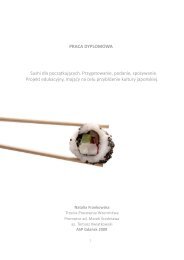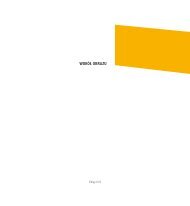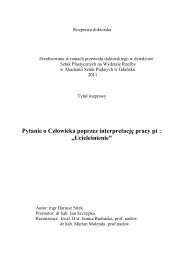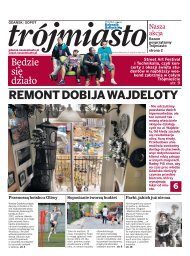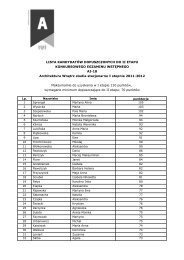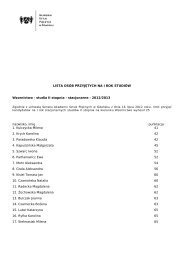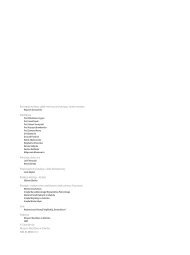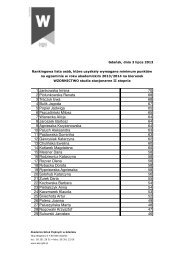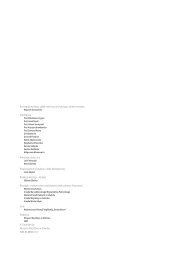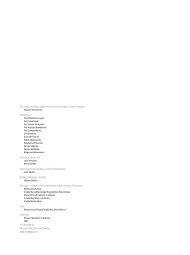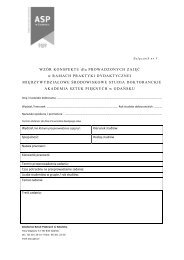P o czet dziek anó w - Akademia Sztuk Pięknych w Gdańsku
P o czet dziek anó w - Akademia Sztuk Pięknych w Gdańsku
P o czet dziek anó w - Akademia Sztuk Pięknych w Gdańsku
You also want an ePaper? Increase the reach of your titles
YUMPU automatically turns print PDFs into web optimized ePapers that Google loves.
E L Ż B I E T A K A L<br />
of PGS (the State Gallery) in Sopot, and the cancellation of the graduating exhibition<br />
of Rafał Ewertowski in Baltic Centre of Culture – all these events, and not only these,<br />
demonstrate that the phenomena that could be discussed or even negated but could<br />
not be annulated were difficult to accept and were also feared. And, on the other hand,<br />
that the contestation of the academic discourse is possible only if the discourse itself<br />
does exist. The within makes the frame possible and meaningful, too, and the frame, on<br />
the other hand, creates the necessary context for the inside. And the artistic activities of<br />
the representatives of the painting of the Academy are not univocal and the departures<br />
from the modernistic search for one truth towards postmodernist narrations of a smaller<br />
format, as illustrated by the “mechanical” works of Roman Gajewski or the installations,<br />
objects and photograms of Hanna Nowicka-Grochal, which are sometimes associated<br />
with the so-called feminist current.<br />
The often rewarded presence of the representatives of the older and the middle-aged professors’<br />
body in the artistic life and on the stabilizing market of arts, on the one hand, and<br />
the successes of Dominik Lejman, for instance, the representative of the next generation<br />
of Gdańsk painters, confirmed by the Passport of Polityka Prize, on the other hand, prove<br />
that the death of the easel painting, which is the symbol of academic education and its<br />
status in the changing world, is neither necessary, nor inevitable. On the contrary, its perfection<br />
of realization, guaranteed by that education, is being combined with the use of<br />
the new pictorial means that have not been typical to the art of painting. The exhibitions<br />
that took place simultaneously in Kraków in June of 1999: Municipal Maneuvers of Robert<br />
Rumas (born in 1966) in the Zderzak Gallery, and the painting art of Władysław Jackiewicz<br />
(born 1924) in the Artemis Gallery, can be quoted as the example and the symbol of a<br />
different kind of consensus, the consensus of time and space, so to say.<br />
non-art; that was is within, together with all the related phenomena, and sanctioned institutionally,<br />
from that what is outside and do not belong to the Academy. And it was the<br />
inside, the institution, or rather the aesthetical model thereof founded that shaped the<br />
criteria of value, and determined whether the object could or could not be considered as<br />
the representation of a certain artistic discipline. And it was the activity of the frame, the<br />
situation of the outside of the institutional aesthetics – exemplified by works and acts of<br />
Krechowicz, Haras, Czerwonka, Ostrogórski, Miszkin, Pereda, and the “Expressionists of<br />
the 1980s”: Model, Bauć, Witkowski, Zaremba, and others – that could except or not the<br />
process of the annexation of the new values. The area within the frame kept expanding,<br />
and new strategies and ideas hitherto absent started to be recognized and included in the<br />
academic discourse. Of course, they were further processed according to their individual<br />
character. What is most essential, however, is the fact that the activity of the frame was<br />
generated by the inside area, as it was being created by the graduates of the Academy.<br />
The new activities that, owing to their scale and destructiveness, started to be labeled<br />
as “the New Gdańsk School”, started to be more and more prominent in the 1990s. The<br />
artists who graduated from the Academy settled in the “regained” territory like the Wyspa<br />
Spichrzów Gallery, or later Łaźnia (Municipal Bath). They rejected the traditional painting<br />
or sculpture, as well as the modernist call for the autonomy, and they included their<br />
artistic activity in the social discourse. The activity of Grzegorz Klaman and other painters<br />
who were the Academy graduates: Robert Rumas, Marek Rogulski, Piotr Wyrzykowski,<br />
Jacek Staniszewski; the galleries and the foundations that they organized; the activity of<br />
CUKT; the numerous editions of the AMS External Gallery – all these activities created a<br />
new option for the official institutional and the aesthetical model. Adding to its importance<br />
was the fact that it was convergent with the general trends in arts of that period.<br />
A conflict around the CSW Łaźnia Gallery, conceptual changes regarding the activities



